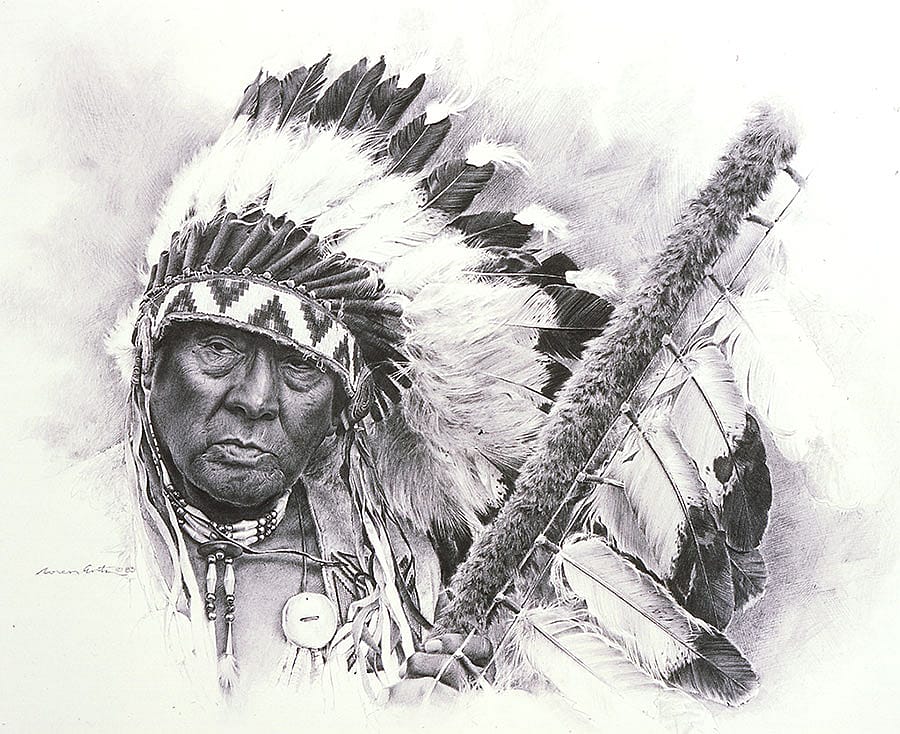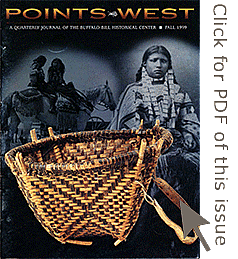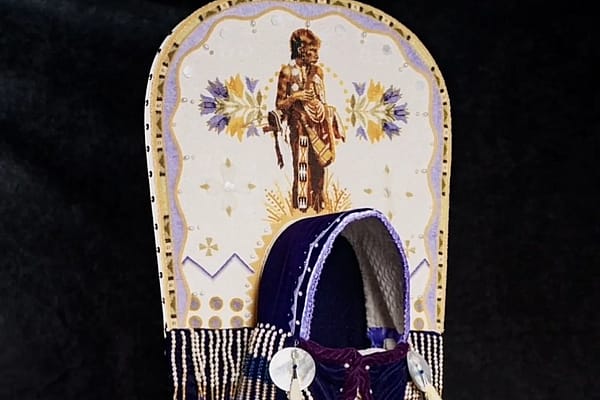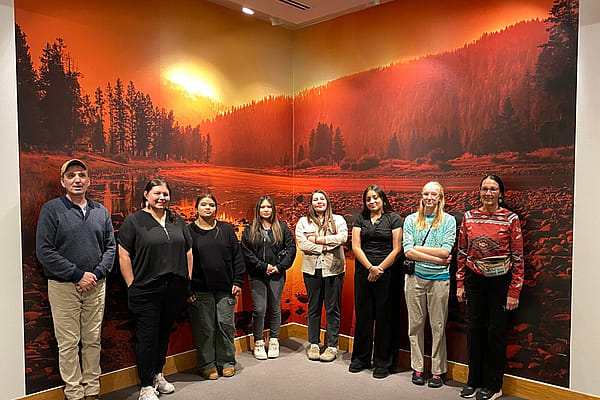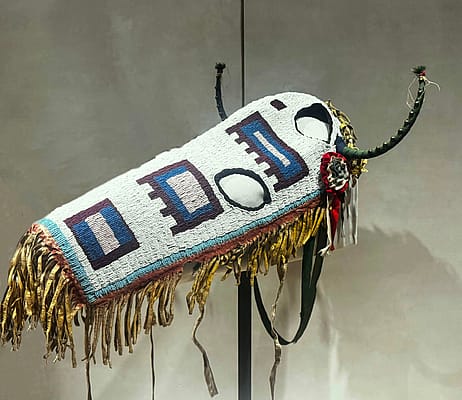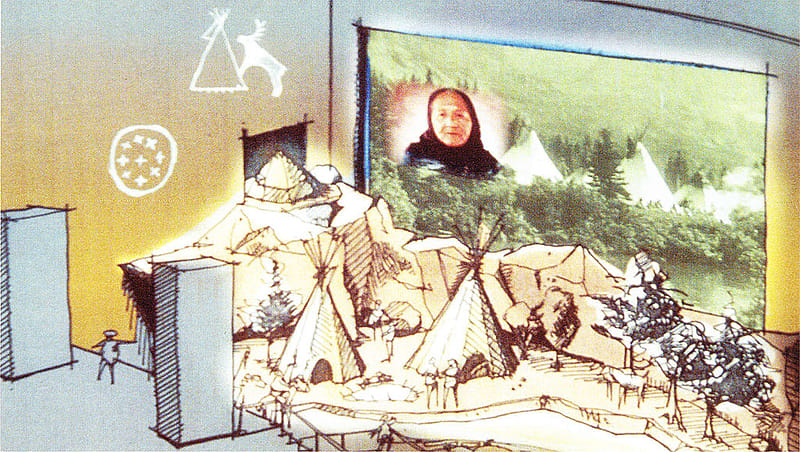
The Plains Indian Museum: A Reinterpretation – Points West Online
Originally published in Points West magazine
Fall 1999
The Plains Indian Museum: A Reinterpretation
By Emma I Hansen
Curator Emerita, Plains Indian Museum
Ed. note: A look back at the vision for the “new” Plains Indian Museum in advance of the reinstallation in 2000.
At its June 1999 meeting, the Center [of the West]’s Board of Trustees approved a plan for the reinterpretation of the Plains Indian Museum, a project that will begin on September 27, 1999, and end with the opening of the new exhibitions in June 2000. This new interpretation of the Museum’s collections will tell the important story of the lives of Plains Indian people, their cultures, traditions, values and histories as well as the contexts of their lives today. The purpose of the reinterpretation is to create, in the words of Advisory Board member and Crow tribal historian Joe Medicine Crow, “a living breathing place where more than just Indian objects are on display.”
Planning for this reinterpretation has taken place over five years of meetings of the Museum’s Advisory Board and Museum staff and represents an unprecedented involvement of Indian people in developing a major museum exhibition. A mission statement developed through these meetings has guided the reinterpretation process:
To educate and advance knowledge about living American Indian cultures, their histories, arts and traditions for current and future generations. To achieve this goal the Plains Indian Museum will diligently seek to acquire, preserve, conserve, exhibit, and interpret cultural materials from the prehistoric past to the present. The Museum’s belief is that the past is best used when it serves the present and the future.
The reinterpretation represents a significant shift in approach from traditional natural history or art historical presentations of Plains art and cultures. In recent years, Native Americans have challenged natural history museums as cultural and educational institutions for presenting one-dimensional images of Indian people, representing tribal cultures as frozen in the nineteenth century, and emphasizing objects over the vitality of present day lives. In contrast, art historical exhibitions and publications have emphasized the aesthetic qualities and techniques of American Indian art often devoid of the cultural contexts.
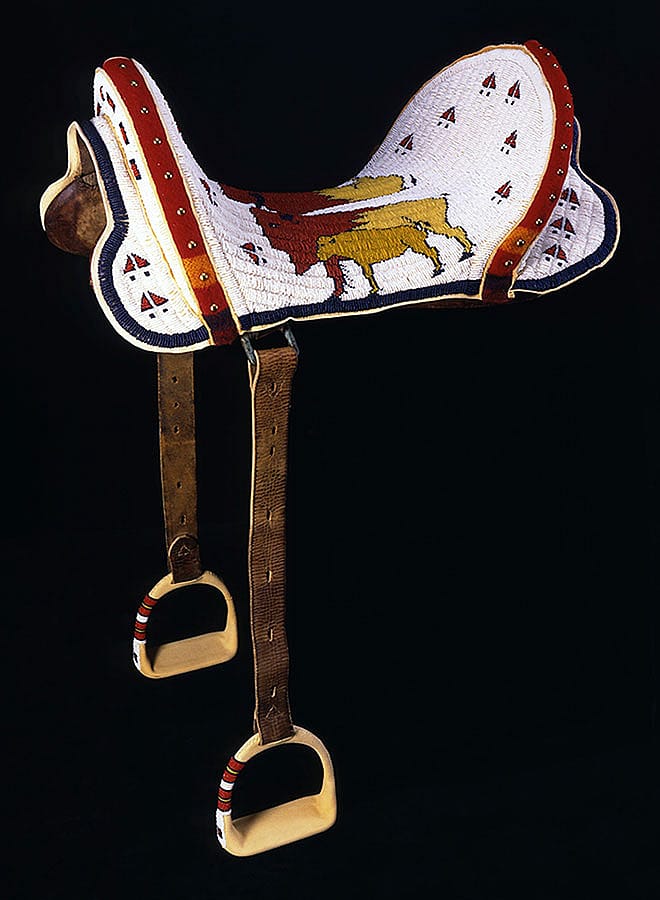
Traditional Indian materials, while admired within their cultural contexts for craftsmanship or design, are a part of the cultures that produced them and have important social, economic, or spiritual functions. According to Lloyd New, a member of the Plains Indian Museum Advisory Board and Founder of the Institute of American Indian Art: “Although Indians of the past probably never considered themselves to be practicing artists in pursuit of art for its own sake, art was nonetheless integral in the growth of Indian culture. For them, art and culture are inseparable-art is essential to the shaping of culture and simultaneously shaped by it.”
With its nationally significant collection, since 1979 the Plains Indian Museum has been a leader in bringing about the public recognition of the quality of Plains art. Although the Museum is one of the most popular components of the Center, visitor surveys reveal our audience has limited knowledge and first-hand experience with Indian people. Through the permanent and special exhibitions of the Plains Indian Museum, visitors have learned about the beautiful objects made by Indian people, but less about the stories of the people behind the objects, and the special contexts in which these objects were made and used in daily and ceremonial life.
The reinterpretation is planned for visitors to gain knowledge and insights about Plains Indian cultures, traditions, and contemporary lives as well as to find relevancy in these issues for their own lives. The interpretation will take advantage of new technology through the use of interactive computers and experiential exhibitions and programs. Native languages and songs will be integrated within the exhibitions and audiovisual programs, and contemporary voices will guide the presentation. New interpretive themes and gallery installations include:
The People of the Plains
Will provide an introduction to the diverse Plains peoples and their environment, languages, histories and traditions.
Wisdom of the Elders
Within a reconstructed Hidatsa earth lodge, an audiovisual program will address spirituality and beliefs about tribal origins and sacred sites and the passing of knowledge from generation to generation.
Land of Many Gifts
Will focus on the creative use of resources of the Plains through the economies of Plains village farmers and hunters and nomadic buffalo hunters.
Land of Many Gifts: Buffalo
A scene of Cheyenne speaking men, women, and children, walking and on horseback will lead visitors to this gallery which focuses on the economic and spiritual importance of the buffalo, and the roles of warriors and hunters. [Ed. note: this is now referred to as “Cheyenne Migration.”]
Seasons of Life
Using tipis, figures and accouterments representative of the Blackfoot of the 1870s accompanied by special lighting and sound effects and an audiovisual program, Seasons of Life will show economic and ceremonial activities taking place throughout the year.
Honor and Celebration
Will address the ceremonial aspects of Plains Indian lives, both past and present and the rites of passage and leadership roles that sustain tribal traditions.
Encounters
Will describe the forces that threatened the physical and cultural survival of Plains Indian people in the 19th century: depopulation through disease and starvation, destruction of the buffalo and loss of lands and traditional economies, warfare, the establishment of reservations, and influences of missionaries and government officials.
Adversity and Renewal
Will emphasize the endurance and survival of Plains Indian people and renewal of traditions and community life. A goal for this presentation is that visitors will develop an understanding that despite all the events that have threatened tribal cultures, the story of Plains Indian people is a continuing one with the greatest contributions to themselves and to society yet to come.
Special Exhibitions Gallery
Will provide a venue for exploring changing exhibition themes and for hosting traveling exhibitions. The gallery has been designed with adaptable exhibition cases that can be repositioned for changing exhibitions or moved out for special exhibitions that travel with their own casework. Ed. note: this space is now dedicated to the exhibition of our Paul Dyck Plains Indian Buffalo Culture Collection.]
Resource Center
Will invite visitors to get a “behind the scenes” glimpse of the Plains Indian Museum collections. With objects exhibited in open storage and computers, visitors will be able to research specific Museum objects and related themes.
The Plains Indian Museum reinterpretation will position the Center [of the West] as one of the leaders in the museum field in educating the public about Indian art and cultures. It will also provide an important venue for residents of the region, including families and school groups, to recognize the cultural achievements of the Native people of the Great Plains.
Post 192
Written By
Nancy McClure
Nancy now does Grants & Foundations Relations for the Center of the West's Development Department, but was formerly the Content Producer for the Center's Public Relations Department, where her work included writing and updating website content, publicizing events, copy editing, working with images, and producing the e-newsletter Western Wire. Her current job is seeking and applying for funding from government grants and private foundations. In her spare time, Nancy enjoys photography, reading, flower gardening, and playing the flute.
